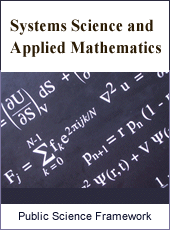Systems Science and Applied Mathematics
Articles Information
Systems Science and Applied Mathematics, Vol.1, No.2, Oct. 2016, Pub. Date: Sep. 23, 2016
Features of Active Particle Brownian Walk Dynamics Excited by White Noise in Media with Non-Linear Friction Which Value Depends Partially on Particle Vivacity Level
Pages: 13-22 Views: 4319 Downloads: 996
[01]
Vladimir A. Dobrynskii, Institute for Metal Physics of N.A.S.U., Kiev, Ukraine.
It is known a long time (about one century ago) that there is a phenomenon of “tunnelling”, i.e. passage of low-energy elementary particles through an energetic barrier that ones could not surmount classically. Explanation of the phenomenon is made in the quantum mechanic framework using the Heisenberg uncertainty principle. The phenomenological model presented here permits to explain the given phenomenon in the classic physics framework provided that the particles interact with a space-time continuum. In other words, in the model, it is assumed that both the particles and 1-dimensional medium where they make their Brownian walks under action of “white” noise are active and do interact each other. We assume additionally that the noise influence on the particles dynamics is much deeper than simple stimulating of the Brownian walks and consists in changing of the internal particle status (property) calling by vivacity. Under such the assumptions a few active particles increase the vivacity so much to penetrate over the impermeable friction barrier and to run in the positive half-axis depth, i.e. to “tunnel” in domains which are situated behind the aforesaid barrier. Making a series of snapshots of 1-dimensional frequency distribution function of an ensemble of particles we are convinced in the aforesaid.
Active Particle, Vivacity, Natural Internal Frequency, Frequency Distribution Function
[01]
Rěvěsz P. Random walk in random and non-random environments. World Scientific. Singapore, 1990.
[02]
Haken H. Synergetics. Springer. Berlin, 1983.
[03]
Haken H. Advanced synergetics. Springer. Berlin, 1985.
[04]
Zaslavsky G. M., Sagdeev R. Z., Usikov D. A. and Chernikov A. A. Weak chaos and quasi-regular patterns. Cambridge University Press, Cambridge, 1987.
[05]
Schuster H. G. Deterministic Chaos. Springer. 3 rd edition. Berlin, 1995.
[06]
Karatzas I. and Shreve S. E. Brownian motion and stochastic calculus, Springer. 2 nd edition. Berlin, 1996.
[07]
Vavrin D. M., Ryabov V. B., Sharapov S. A. and Ito H. M. Chaotic states of weakly and strongly nonlinear oscillators with quasiperiodic excitation. Phys. Rev E 53, 1996, pp. 103-114.
[08]
Ivanov M. A, Dobrynskiy V. A. Random walk of oscillator on the plane with non-homogeneous friction. Int. INFA-ANS J. Problems Nonlinear Analysis in Engineering Systems”, vol. 12, no. 1 (15), 2006, pp. 101-116.
[09]
Ivanov M. A, Dobrynskiy V. A. Stochastic dynamics of oscillator drift in media with spatially non-homogeneous friction, J. Automation and Information Sci., vol. 40., no. 7, 2008, pp. 9-25.
[10]
Dobrynskii V. A. Unusual frequency distribution function shape generated by particles making Brownian walk along line with monotone increasing friction, Int. J. of Mathematics and Computation Sci., vol. 1., no. 3, 2015, pp. 91-97.
[11]
Walecka J. D. Topics in Modern Physic: Theoretical Foundations. World Scientific, 2013, 500 pp.
[12]
Razavy M. Quantum Theory of Tunneling. World Scientific. 2 nd edition, 2014, 792 pp.

ISSN Print: Pending
ISSN Online: Pending
Current Issue:
Vol. 2, Issue 2, April Submit a Manuscript Join Editorial Board Join Reviewer Team
ISSN Online: Pending
Current Issue:
Vol. 2, Issue 2, April Submit a Manuscript Join Editorial Board Join Reviewer Team
| About This Journal |
| All Issues |
| Open Access |
| Indexing |
| Payment Information |
| Author Guidelines |
| Review Process |
| Publication Ethics |
| Editorial Board |
| Peer Reviewers |


